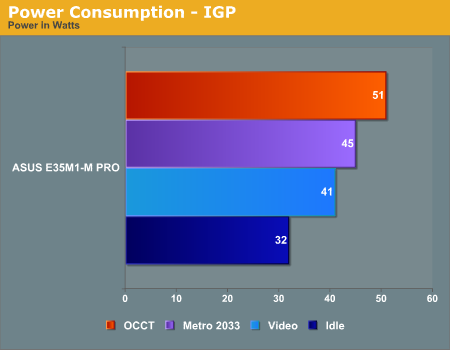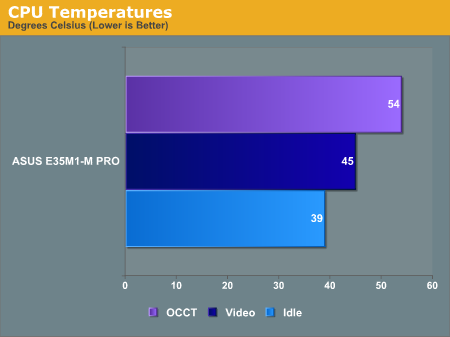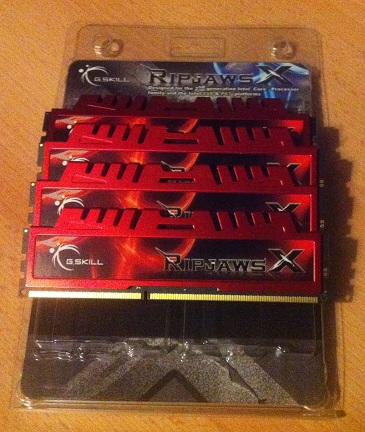ASUS E35M1-M Pro Review - Anyone For Fusion?
by Brendan van Varik on October 25, 2011 5:00 AM EST- Posted in
- Asus
- Motherboards
- Fusion
- E-350
Test Setup
| Processor |
AMD Fusion APU E-350 Dual-Core 1.6 GHz Up to 2 "Bobcat" cores, FT1 BGA 80 Stream Processors, 500 MHz |
| Motherboards | ASUS E35M1-M PRO |
| Cooling | Standard Cooling |
| Power Supply | Jeantech 250 W |
| Memory | G.Skill RipjawsX F3-14900CL9Q-16GBXL |
| Memory Settings | DDR3 1333MHz - 9-9-9-24 1T at 1.5 V |
| Hard Drive | OCZ Vertex 3 240GB |
| Optical Drive | Samsung SH-S223Q |
| Case | Dimastech Bench Table |
| Operating System | Windows 7 64-bit Ultimate |
| SATA Testing | OCZ Vertex 3 240GB |
| USB 2/3 Testing | Patriot 64GB SuperSonic USB 3.0 |
Many thanks to…
Before we go any further, I'd like to take the time to thank G.Skill for providing us with a set of their RipJawsX RAM for my future AMD reviews, in particular, the F3-14900CL9Q-16GBXL kit of which two sticks were used. It is a 16GB (4x4GB) kit which is rated at DDR3-1866MHz with 9-10-9-28 timings on as little as 1.5 volts. It is currently available from Newegg for $149.99.
Power Consumption
Power consumption was tested on the system as a whole with a wall meter connected to the power supply, while in an IGP configuration. This method allows us to compare the power management of the UEFI and the board to supply components with power under load, and includes typical PSU losses due to efficiency. These are the real world values that consumers may expect from a typical system (minus the monitor) using this motherboard. The power supply used for this test was a generic 250W model from JeanTech.

Out of the A50M motherboards which we have had on test, the ASUS E35M1-M PRO has the lowest average power rating across the four tests which we ran.
CPU Temperatures
With most users running boards on purely default BIOS settings, we are running at default settings for the CPU temperature tests. The results of a CPU Temperature test are not easily interpretable – if a motherboard vendor has buffered the amount of copper in the board between the power delivery and the CPU, this lowers the resistance and increases the CPU default voltage causing higher temperatures (but better stability). However, a high temperature could result from using different types of onboard devices, FETs, or the quality of the CPU temperature sensor, so the overall interpretation is purely speculative. The only thing a CPU test can say for sure is how warm the CPU is.
It could be argued that the CPU temperature is an indication of how well (or how adventurous) the vendor has their BIOS configured on automatic settings. A certain number of vendors not making CPU voltage, turbo voltage or LLC options configurable to the end user, which would directly affect power consumption and CPU temperatures at various usage levels.

The thermal tests were conducted without the included fan, just like the other Fusion motherboards. As you would expect, the temperatures are significantly lower if you use the fan. For example, if you stress the system with OCCT, the temperatures come down from 54 °C to just 39 °C. The fan is whisper quiet during normal operation and should not be noticed in a HTPC environment - however, when the system is stressed and the fan speeds up to 100%, it does get quite loud.











66 Comments
View All Comments
C300fans - Tuesday, October 25, 2011 - link
No, because 80sp is really really too weak for gaming.C300fans - Tuesday, October 25, 2011 - link
Even if a 800sp card, GDDR5 128bit is far enough. Can you tell the difference between HD 6790 and HD 6770? I could say, you will probably notice more on the price.silverblue - Tuesday, October 25, 2011 - link
The difference here is that the memory interface is shared by both the CPU and the GPU. It's not all about gaming, but the actual effective use of what's on offer.However, being a geek at heart, I wouldn't mind seeing what the turbo mode plus more memory bandwidth would do for light gaming as well as if the E-450 is only a tiny bit faster than the E-350 even with the extra bandwidth.
duploxxx - Tuesday, October 25, 2011 - link
its already been tested, between 5-10% more perf in general tasks with same consumption. Not bad at all for a small update. No graphics tested yethttp://asia.cnet.com/product/hp-pavilion-dm1-amd-f...
lestr - Tuesday, October 25, 2011 - link
Lap top/netbook review, does not equal desktop especially in a "review" that is a mere single page, maybe two, max. The 350 OC's to ~1.8 +/- and with memory upped to 1600 on a 6320 graphics core the results might be more interesting especially since folks are only now beginning to understand how to OC an APU properly. Drop the mult, crank the FSB for graphics and raise both to stable. That noted, it's certainly not about gaming but over all performance. 80SP's isn't much but more power/speed wouldn't hurt, now would it? 160 would be great. Maybe CPU can get to 2.0 or greater...
Also promised are reviews geared more toward HTPC use rather than gaming... that's like trying to take out an elefunk with a BB gun. Not much point in even going there.
Actually I am more interested in what is going to replace the M50 - 350/450 line - Jan? For now it looks like they're trying to deplete 350 inventories before bringing the 450 here. Even so, a lot of people would like to know.
thanks it's nice to see the interest.
rburnham - Tuesday, October 25, 2011 - link
This board seems too big for an HTPC and too underpowered for a gaming rig. Most people I know who use their computers for basic things (web browsing, spreadsheets) already have laptops and they prefer the portability over a desktop. I am not sure where this board fits in.mino - Wednesday, October 26, 2011 - link
This board is actuall;y great for HTPC for a very important reason - there are people who actually _need_ more than a single PCIe or PCI slot ...But otherwise, the real target would be cheap PC's for kids, secretaries and the like.
jrs77 - Tuesday, October 25, 2011 - link
I'm owning a Zotac IONITX A-E (used as NAS/webclient), an Asus AT3IONT-I Deluxe (used as HTPC) and a Lenovo Thinkpad x121e E350 (for travelling and whatever). All of them are basically the same when it comes to powerconsumption and they're all up to the task of playing Full HD-media.People will allways moan about the low-power CPUs of those systems, but if you don't do anything else then browsing the web and playback some media, there's nothing to complain about really. These systems even run older games perfectly fine, or they make for a good system to run a second client for EvE Online, etc.
Geofram - Tuesday, October 25, 2011 - link
In windows, will it stream Netflix without a problem?I used to have a Atom based HTPC, and HD content on Netflix wouldn't properly use the GPU acceleration, and hence, it wouldn't play smoothly. Something in the Silverlight acceleration didn't detect and use GPU for everything, and would fall back to CPU. So I'm more worried about that than I am about if it will play a Blu-ray, yet it's something I never see checked.
RayMort - Wednesday, October 26, 2011 - link
This is exactly what I need to know too. My 6 year old PC with an AMD 3500 dual core processor can't decode Netflix HD streaming for the same reasons. I want to upgrade, but I want to be sure it will do Neflix HD before I purchase.